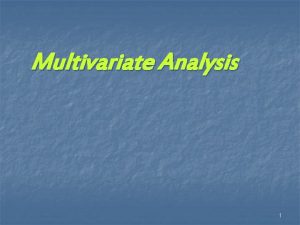Using Factor Analysis and Multivariate Analysis of Variance


- Slides: 2

Using Factor Analysis and Multivariate Analysis of Variance to Explore Academic Achievement in the 2016 Monitoring the Future Study Stefanie N. Kairs – NU Scholars Program, National University, San Diego, CA Introduction Dependent Variable The 2016 Monitoring the Future (MTF) 8 th- and 10 th-Grade surveys are part of an annual, long-term study of American adolescents and adult high school graduates conducted by the University of Michigan’s Institute for Social Research. Study data have been collected since 1975, when the Institute of Social Research opened. The 2016 MTF survey involved 45, 500 participants in grades 8, 10 and 12, and sampled from 372 secondary schools across the country 1. With an estimated 500 variables per year, the survey covers a broad range of topics including drug use, attitudes and beliefs regarding drug use, and lifestyle choices and values. This secondary data analysis used factor analysis to extract the underlying structures for student achievement, their academic attitudes and environment, and at-risk behaviors or delinquency. The extracted factors were then used as the dependent variables in multivariate analysis of variance (MANOVA). The MANOVA analysis evaluated the relationship between the demographic independent variables for gender, ethnicity, and population density and the dependent factors for academic success, academic environment, and at-risk behaviors Methods FACTOR ANALYSIS was performed in Studio using the FACTOR procedure with varimax rotation. The REORDER option was used to sort variables by their factor loadings and the SCREE option was used to produce a scree plot. The parallel analysis criterion for factor retention was computed using a script previously published by Brian O’Connor 2. Principal components analysis with a communality estimate of one was used for extracting factors. WUSS 2019 Results FACTOR ANALYSIS Three factors relating to achievement, environment, and at-risk behaviors were extracted from 14 input variables. The rotated factor pattern is shown in Figure 1 and the screen plot is shown in Figure 3. MANOVA A statistically significant overall effect was found for each independent variable: gender (Wilks’ λ = 0. 96, F= 273. 23, df= (3, 17711), p<0. 0001); race (Wilks’ λ = 0. 86, F= 479. 83, df= (6, 35422), p<0. 0001); population density (Wilks’ λ = 0. 98, F= 65. 31, df= (6, 35422), p<0. 0001). Race explains approximately 14% of the variance in academic achievement, academic environment, and at-risk behaviors (Pillai’s trace = 0. 145, p<0. 0001). Gender explains 4% of the variance and population density only 2%. 99. 76% CI Female – Male 0. 420 0. 375, 0. 464 Achievement Race White – Hispanic 0. 132 0. 072, 0. 192 White – Black 0. 457 0. 384, 0. 530 White – Hispanic 0. 853 0. 796, 0. 910 Black – Hispanic 0. 396 0. 313, 0. 479 High – Moderate 0. 064 0. 009, 0. 118 0. 158 0. 091, 0. 221 Moderate – Low 0. 092 0. 032, 0. 152 At-risk behavior Pop. Density Moderate – Low -0. 090 -0. 154, -0. 026 Environment Figure 3. Scree Plot Difference Between Means Gender Environment Figure 1. Rotated Factor Pattern Comparison Achievement Figure 2. SAS Code for Factor Analysis SASTM MANOVA was performed using the GLM procedure. The independent variables were the categorical variables for gender (V 7202), race (V 1070) and population density (pop_density). Gender has two levels, male (1) and female (2). Race had three levels, Black (1), White (2), and Hispanic (3). Population density had three levels, low-density (0), moderate-density (1), and high-density (2). For population density, we were primarily interested in the differences between high-density population centers and all other environments, so a contrast statement was used to code this comparison. All hypotheses were evaluated in the initial analysis. Post -hoc analysis was performed by Tukey’s Studentized Range Test using a Bonferroni correction for multiple testing. Independent Variable Race Pop. Density High – Low Table 1. Tukey’s Post Hoc Analysis Output from MANOVA. Only the comparisons significant at α = 0. 0024 are shown. While statistically significant, the effect of population density on environment and at-risk behavior is very small. Conclusions • Complete data were available for 17, 719 2016 Monitoring the Future respondents from grades 8 and 10. • 3 Factors were extracted from 14 input variables. These factors relate to academic achievement (1), environment (2), and at-risk behaviors (3). • Student environment varies significantly by race. This factor was comprised of variables for parental education, college prep school programs, and remedial schooling (negative loading). References 1 Johnston, The post-hoc analysis results are summarized in Table 1. Only the comparisons with a statistically significant difference at the alpha = 0. 0024 level are shown. L. D. , et al. (2017). Monitoring the Future: A Continuing Study of American Youth (8 th- and 10 th. Grade Surveys), 2016. Ann Arbor, MI: Inter-University Consortium for Political and Social Research [distributor]. 2 O'Connor, B. P. (2000). SPSS and SAS programs for determining the number of components using parallel analysis and Velicer’s MAP test. Behavior Research Methods, Instruments & Computers, 32(3), pp. 396 -402. https: //scholars. nu. edu/

Using Factor Analysis and Multivariate Analysis of Variance to Explore Academic Achievement in the 2016 Monitoring the Future Study Stefanie N. Kairs – NU Scholars Program, National University, San Diego, CA Enlarged & Supplemental Figures Figure 2. SAS Code for Factor Analysis Figure 1. Rotated Factor Pattern (enlarged) Figure 3. SAS Code for MANOVA Figure 4. Scree Plot Figure 5. Parallel Analysis Output Click Here to Return to the Main Poster WUSS 2019 https: //scholars. nu. edu/



